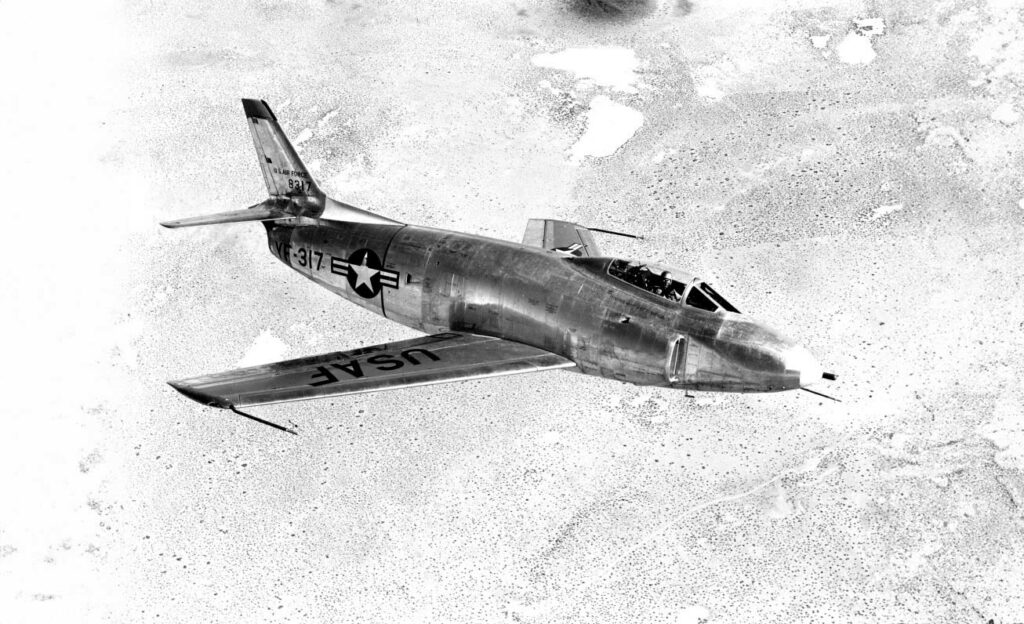The North American YF-93 was a U.S. Air Force prototype fighter jet, developed from the F-86 Sabre in the early 1950s.
In brief
The North American YF-93 was an American prototype fighter aircraft, developed in the early 1950s as an adaptation of the famed F-86 Sabre. Intended initially as a penetration fighter, it featured a distinctively long fuselage and a pair of powerful General Electric J47 turbojet engines. The YF-93 was characterized by its large air intakes and a sleek design aimed at achieving high speeds and superior performance at high altitudes. Despite its advanced features and promising capabilities, only two prototypes were built. The YF-93 failed to secure a production contract, largely overshadowed by other fighter designs that better met the evolving needs of the U.S. Air Force during that period.
The North American YF-93 was a significant development in the evolution of jet fighters in the United States, marking a transition in design and performance capabilities in the early jet age.
History of the Development of the North American YF-93
In the early 1950s, the U.S. Air Force sought to expand and improve its fighter aircraft capabilities, particularly in terms of speed, range, and altitude performance. This period was characterized by rapid advancements in jet technology and an increasing focus on supersonic flight capabilities. Against this backdrop, the North American YF-93 was developed.
The YF-93 originated from a need for a high-altitude penetration fighter. North American Aviation, building on the success of the F-86 Sabre, initiated the development of this new aircraft. The program was launched with the aim of creating a fighter that could operate at higher altitudes and at greater speeds than existing models.
The design and development of the YF-93 began in the late 1940s, with the first prototype taking to the skies on February 24, 1950. The aircraft did not have a NATO nickname, being a prototype with limited production.
Design of the North American YF-93
The North American YF-93 was designed as a radical departure from the F-86, though it shared some lineage. The most notable change was its much longer and wider fuselage, designed to house larger fuel tanks for extended range and two General Electric J47 turbojet engines, each providing significant thrust.
The aircraft had a length of about 17.4 meters (57 feet) and a wingspan of 11.3 meters (37 feet). Its large, distinctive air intakes were designed to feed the more powerful engines, a feature that set it apart from its predecessors.
One advantage of the YF-93’s design was its expected high-altitude performance, thanks to the increased power and improved aerodynamics. However, the aircraft also faced drawbacks, such as increased weight and complexity. The design represented a balancing act between speed, range, and maneuverability.

Performance of the North American YF-93
The YF-93’s performance was a key area of focus during its development. The twin General Electric J47 engines were capable of producing a combined thrust that was significantly higher than the single-engine fighters of the time. This power was expected to give the YF-93 a top speed exceeding that of the F-86, along with a higher service ceiling and greater range.
In terms of speed, the YF-93 was projected to reach speeds close to the sound barrier, though it was not designed as a supersonic aircraft. Its altitude capabilities and range were also expected to be superior to many contemporaries, positioning it as a high-performance fighter.
However, when compared to other aircraft in development at the time, such as the North American F-100 Super Sabre, the YF-93’s advantages were less clear. The evolving focus towards supersonic flight and multirole capabilities made the YF-93 less attractive to the Air Force as a specialized penetration fighter.
Variants of the North American YF-93
The North American YF-93 program produced two prototype aircraft. These prototypes, designated YF-93A, were essentially the only variants of the design. There were no significant modifications or alternative versions developed beyond these initial prototypes, as the program did not advance to full-scale production.
Military Use and Combat of the North American YF-93
The YF-93A never saw active military service or combat. As an experimental prototype, its role was limited to testing and evaluation. The aircraft’s primary purpose was to demonstrate the capabilities and potential of the design for high-altitude, high-speed missions.
The YF-93 did not participate in any conflicts, nor was it sold to other countries. Following the conclusion of its testing program, the aircraft was not adopted by the U.S. Air Force, and the project was ultimately discontinued. The technological advancements and lessons learned from the YF-93 program, however, contributed to the development of subsequent fighter aircraft.
The North American YF-93 was a noteworthy experiment in the advancement of jet fighter technology. While it did not enter production or see combat, its development reflected the rapid evolution and ambitious aims of early jet fighter design. The YF-93’s legacy lies in its contribution to the understanding of high-speed, high-altitude flight, influencing the design principles of future generations of fighter aircraft.
Back to the experimental aircraft section.